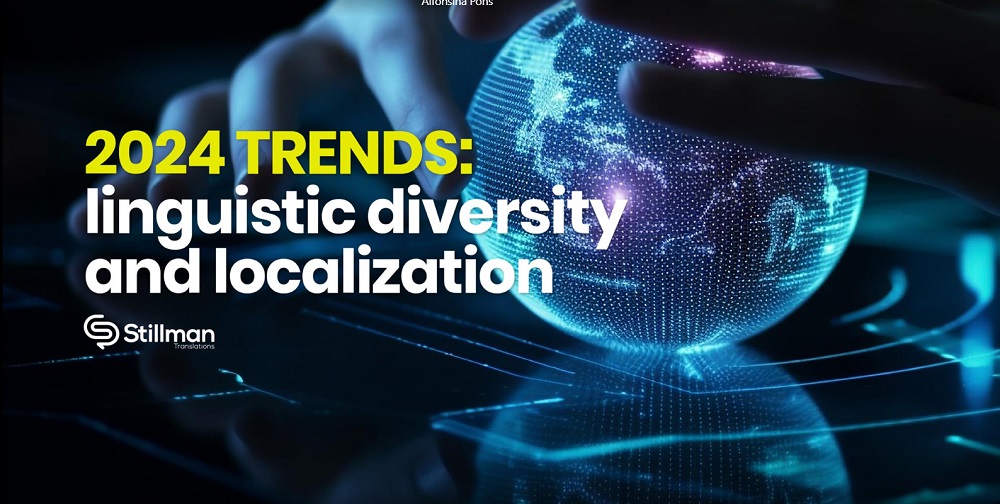
Tech and streaming drive media consumption changes, shaping content creation, translation, and online interaction. Explore 2024’s localization trends
How we consume media and communicate has undergone a significant transformation fueled by technological advancements and streaming platforms. As we navigate this landscape, several trends have emerged, reshaping how we approach content creation, translation, and online interaction. Let’s delve into four key trends shaping the localization industry in 2024.
TREND #1: Subtitles and Voice-Based Localization
The use of subtitles and voice-over is a big trend that’s making a splash, changing how we share stories worldwide.
Streaming platforms have become the gateway to a plethora of content. This cultural shift has sparked a growing preference among younger audiences for subtitles, even in their native language. Because of TikTok and how social media works, people like using subtitles to make watching videos better and to be able to connect with different types of content.
However, the demand for subtitling goes beyond mere translation. It requires a delicate balance of linguistic accuracy and creative expression, often constrained by time and character limits. While AI technology aids in this process, its effectiveness remains limited in capturing the nuances of language and culture.
Voice-based localization presents a similar challenge as voice assistants become ubiquitous in our daily lives. Businesses must adapt to accommodate customers in any language or dialect, reflecting the increasingly globalized nature of commerce and communication.
As we use technology more, it’s really important to be able to adapt to different languages to meet the needs of people all around the world. Whether it’s streaming movies, videos, or podcasts, the ability to provide seamless localization enhances the accessibility and appeal of content across borders. Embracing these trends fosters inclusion and unlocks new opportunities for global storytelling and connection in the digital age.
TREND #2: Integration of Large Language Models (LLMs)
The integration of Large Language Models (LLMs) with other software heralds a new era of productivity enhancement and innovation. The focus now shifts to leveraging LLM-driven features to transform translation workflows and expand the horizons of localization.
Translation Management Systems (TMS) stand at the forefront of this evolution, seamlessly including LLM capabilities into the translation process. This combination makes work easier and helps translation companies become more like important partners instead of just people who do a job.
In this dynamic landscape, translation agencies play a pivotal role in guiding organizations through the complexities of translation technology. From offering consultation on LLM integration to managing intricate localization projects across multiple languages, agencies are prepared to deliver unparalleled value.
Moreover, as custodians of linguistic and cultural expertise, translation agencies are essencial allies in the quest for global expansion. Their ability to perform rigorous quality assurance checks ensures the accuracy and integrity of critical translations, safeguarding brands’ reputations in diverse markets.
In essence, the AI revolution in translation isn’t about usurping human expertise; it’s about fostering collaboration and driving change. By embracing LLM integration, translation agencies pave the way for a future where language barriers dissolve, and communication knows no bounds.
TREND #3: Multilingual SEO and Google’s Image Translation
In the changing world of the internet, 2024 brings some exciting changes to Google Search that businesses and content creators need to adjust to.
Multilingual SEO transcends the boundaries of traditional translation, offering businesses a vital strategy for global expansion. It’s about crafting online content that resonates with diverse audiences worldwide, ensuring maximum visibility and engagement across language barriers.
Google has come up with something big that could change how we explore online: translating images. Soon, Google’s advanced algorithms will soon be able to read and translate words in pictures automatically. This innovation presents challenges and opportunities for businesses, especially those reliant on language-specific products or services.
Navigating the complexities of Google Search and Ads requires expertise, especially in the face of constant evolution. If your online marketing strategy needs a boost, now is the time to take action and stay ahead of the curve.
In today’s world, where the community speaks many languages and is connected online, businesses must learn how to use multilingual SEO if they aim to thrive on the internet. Let us help you navigate this new frontier and unlock the full potential of your online presence.
TREND #4: Native Content and Linguistic Diversity
In today’s rapidly evolving global landscape, the demand for native content is reaching unprecedented levels. As languages continue to thrive and communities seek authentic, locally tailored experiences, businesses recognize the importance of catering to diverse linguistic demographics.
Everywhere from growing markets to big cultural hubs, people want content made in their own language. Understanding which languages to prioritize in your strategies is paramount to success. Using localization services isn’t just about reaching new markets; it’s about being part of globalization and really connecting with people.
Consider the case of Portuguese, a language experiencing remarkable growth in its speakership. With a 297% increase over the past century, Portuguese has outpaced major languages like English, Chinese, Hindi, and Spanish. Spoken in regions spanning Brazil, Portugal, Mozambique, Angola, and beyond, Portuguese presents abundant opportunities for businesses looking to expand their reach.
In conclusion
The digital age presents endless possibilities for businesses embracing diversity and leveraging technology to unlock global narratives. If they pay attention to new trends and think globally, they can understand the internet better and connect with people from different places in a meaningful way. Let’s take advantage of linguistic diversity and make content that people all around the world can relate to in this time of being connected and coming up with new ideas.
